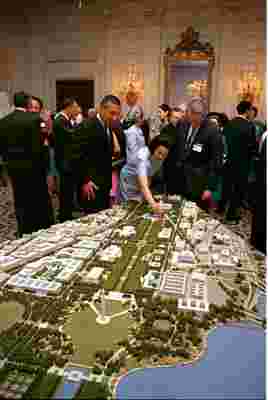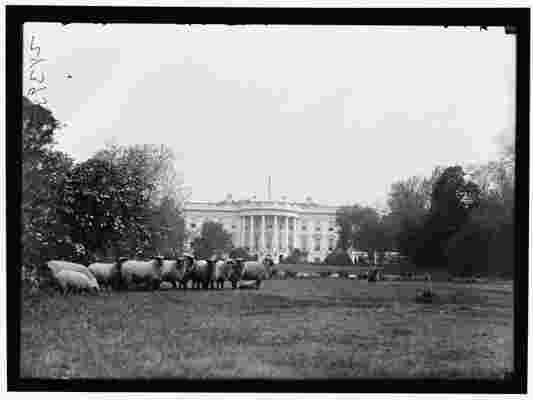Imagine the scrutiny of planting a presidential garden—the whole nation is awaiting your bulbs to bloom. But from Thomas Jefferson’s far-flung horticultural obsessions to the Kennedys’ ravishing rose garden (devised by design icon Bunny Mellon, of course), the presidential gardens have long captivated the public imagination. Now, Marta McDowell’s All the Presidents’ Gardens (Timber Press, $30) explores the untold stories of America’s best-known lawn. Here, we share eleven fun facts about the White House gardens and other presidential plots, revealed in the book. Read on to find out which president was the first to plant a vegetable garden, and who was skimming shopping money off the manure fund.
1. At Mount Vernon, George Washington’s Virginia home, the president planted so many roses that it took 12 days each June to pick the petals, which his wife, Martha, distilled into rosewater.
2. Despite his reputation as an impassioned horticulturist, Thomas Jefferson actually scaled back the presidential gardens, an act he felt would reinforce his ideas about small government. He cut off more than 70 acres that were part of the presidential palace, designating the area as a more democratic public common.
3. Dolly Madison was not inclined to garden—in those days, it was considered a pastime for men—but she may have invented the flower crown. “I will avail myself of your offer to chuse me a facinating Headdress,” she wrote to her friend Phoebe Pemberton Morris, who lived in Philadelphia. “It must be of large size—I enclose you 20$ my darling, & you will add to the Bonit or Turbin, some artificial Flower or fruit for the Head.”

Ladybird Johnson examines the plans for the White House garden.
4. James Madison, on the other hand, planted the first documented presidential vegetable garden. At the time, presidents paid the expenses of feeding guests out of their own pockets, and Madison’s list of seeds to purchase included several varieties of cabbages and radishes, as well as carrots, beets, parsnips, broccoli, and more.
5. John Quincy Adams had a thing for trees. “In Baltimore he picked up acorns from a white oak on the battleground at North Point, fought just after the White House had been burned, and brought them back to plant in his nursery,” writes McDowell. “He collected chestnuts and elm samaras, planted them, and monitored their growth.”
6. John Watt, the head gardener during Abraham Lincoln’s administration, and Mary Lincoln became enmeshed in garden-related fraud. To support her expensive shopping habit, Watt would often pad the bills to give her a little extra spending money, meaning the manure fund often assisted with the acquisition of china, crystal, wallpaper, carpets, and paint.
7. During the Clinton administration, a series of sculptures was installed in the Jacqueline Kennedy Garden in homage to Bill and Hillary’s first date, in which they walked through a Henry Moore exhibition in a sculpture yard. The eight works by American sculptors—all drawn from regional museums—had to be cleared by the Secret Service and needed to withstand strong winds created by helicopters landing nearby.

Under president Woodrow Wilson, twenty Hampshire sheep subbed in for the lawn-mowers who were off at war.
8. Under president Woodrow Wilson, during World War I, a herd of twenty Hampshire sheep kept the White House lawn closely shorn while much of the nation’s workforce was off at war. Ninety-eight pounds of wool—a commodity in high demand—was shorn from that flock and auctioned to benefit the American Red Cross.
9. During the Obama administration, White House carpenter Charlie Brandt created the first White House beehives on record. The colonies—which are strapped down to withstand turbulence from Marine One—produced 140 pounds of honey in their first year.
10. Irvin Williams, head gardener during the first Bush administration, created inventive ways of keeping pests from entering the garden: Fertilizer laced with Louisiana hot sauce discouraged moles and voles, and baskets of Georgia peanuts were strapped to tree trunks to distract marauding squirrels from the precisely planted tulip bulbs. Squirrels, however, had long been welcome on the grounds; in the 1920s one was so tame that members of the press corps nicknamed him Pete. Sixty years later, Ronald Reagan brought acorns from Camp David on a regular basis to feed the squirrels in the Rose Garden.
11. When the Kennedys asked Bunny Mellon to reenvision the East Garden, she came up with a design inspired by a whimsical scene in Lewis Carroll’s Alice in Wonderland where Alice and the Queen of Hearts play croquet in a rose garden using live flamingos for mallets.
RELATED: Go Behind the Scenes in the White House and Other Presidential Homes
